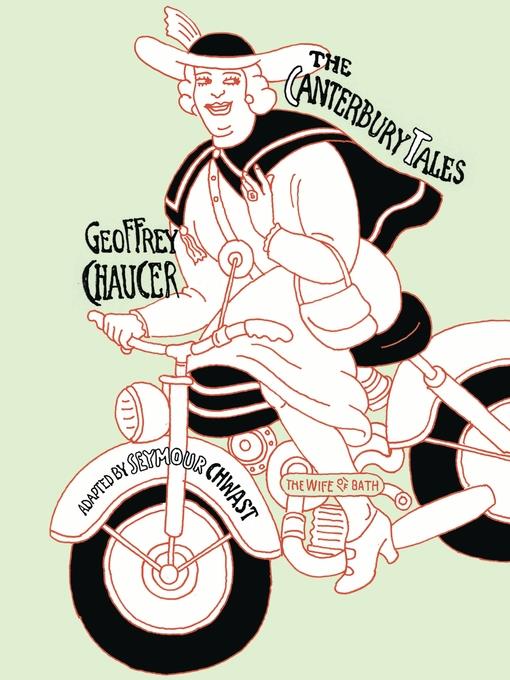
The Canterbury Tales
کتاب های مرتبط
- اطلاعات
- نقد و بررسی
- دیدگاه کاربران
نقد و بررسی

June 27, 2011
Reimagining a 14th-century masterpiece for a modern audience proves to be extremely difficult. Readers who want a very fast survey of the Tales will be satisfied, for famed designer Chwast summarizes everything, not ducking the Miller's enthusiastic bawdiness and the Prioress's pious anti-Semitism. Some of his updatings are clever: the pilgrims travel on motorbikes, and their dialogue frequently uses contemporary slang; in addition, the cartoony style and overall design sometimes work to emphasize a story's point. On the other hand, Chaucer's work hasn't lasted so much because of the tales' plots but because of the personality each pilgrim shows and the subtle way Chaucer handles the interaction of tales and tellers. Chwast's more bombastic approach creates an amusing surface, but doesn't really try to translate the substance of the original. While his bare-bones style simplifies some elements, the elements of the stories stay well-defined.

July 1, 2011
As a follow-up of sorts to his illustrated Dante's Divine Comedy (2010), graphic artist Chwast embraces a kindred spirit in Chaucer.
Though the credit reads "adapted by Seymour Chwast," "transformed" or "subverted" might be more precise. Here the pilgrims who tell the tales ride motorcycles, with the artist himself as the host and Chaucer waving from a sidecar. They spin stories of lust in which characters seduce each other with jaunty language: "Hey, babe, let's party!"; "Come here, big boy. Show me your stuff!" Yet Chwast recognizes that he is doing in large part what Chaucer did, "writing in the English vernacular of the time." As these tales comment upon and interrupt each other, Chwast aims to illustrate nothing less than the human condition, filled as it is with profound differences between men and women, romantic betrayal that barely pays lip service to monogamy, jealousy taken to lethal extremes and fables that have morals that are a little too pat for the narratives they accompany. There are plenty of beheadings, repeated bursts of flatulence and, as the cartoon Chaucer explains, action "complete with swash and buckling." There is also a cross-cultural expanse to the epic storytelling, with biblical figures, Greek gods, Roman emperors and Arabian legends all represented within this graphic condensation of Chaucer's classic into tales that are often as little as a few panels each.
Not quite the achievement that the Divine Comedy was, but a work that finds an artistic common denominator for Chaucer and Chwast.
(COPYRIGHT (2011) KIRKUS REVIEWS/NIELSEN BUSINESS MEDIA, INC. ALL RIGHTS RESERVED.)

September 15, 2011
A delicious cover: the Wife of Bath on a motorcycle, in semimodern garb and wearing a self-satisfied grin. The same clever decanting of old wine into new bottles carries us through all 20-plus Chaucer tales, if compressed a bit. Chwast used the same approach for Dante's Divine Comedy (2010), which was well received. But the missing ingredient in both works, for this reviewer, is color: the freewheeling, stylish hue characteristic of Chwast's half-century-old Push Pin Studio. Whereas the cover sports striking orange, green, and black, the interior pulls back into black and white. Perhaps Chwast was trying to evoke William Caxton's medieval woodcuts for the Chaucer stories. Indeed, Caxton's illustrations feature elaborate design explicitly tailored to a colorless medium, but Chwast's portfolio has centered on color to complement his clear-line penwork, which here looks rather unfinished. VERDICT Chwast's entertaining adaptation suffices as casual reading and can serve as a pathway to the original for students with Chaucer as class assignments. Just keep in mind that the award-winning artist was drawing with one hand behind his back. Includes cartoony nudity and bawdry.--M.C.
Copyright 2011 Library Journal, LLC Used with permission.

October 15, 2011
For his second graphic novel (after Dante's Divine Comedy, 2010), legendary graphic designer and illustrator Chwast tackles another classic work of narrative verse. In his signature visual style, he reinterprets Chaucer's fourteenth-century account of a group of medieval pilgrims entertaining one another on the way to a shrine by telling stories. Although many of the travelers' tales contain spiritual elements, others are strikingly risqu' and irreverent, accounting for the work's enduring popularity. In his introduction, Chwast notes that Chaucer wrote in the English vernacular of the time. He takes a similar approach, popularizing the proceedings by using contemporary lingo and injecting such whimsically anachronistic touches as having the pilgrims travel on motorbikes. The intentional simplicity, bordering on crudeness, of Chwast's line drawings is a fitting match for the brash bawdiness of Chaucer's satires. If much of the work's literary merit is lost, reading Chwast's variation is certainly less demanding than plowing through Chaucer's text. Perhaps, as educators hoped about the Classics Illustrated comics of an earlier era, it will lead curious readers to the original.(Reprinted with permission of Booklist, copyright 2011, American Library Association.)

























دیدگاه کاربران